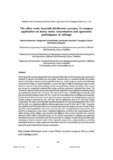Please use this identifier to cite or link to this item:
https://cris.library.msu.ac.zw//handle/11408/682| Title: | The effect water hyacinth (Eichhornia crassipes, L) compost application on heavy metal concentration and agronomic performance of cabbage | Authors: | Mashavira, Martin Mhindu, Rangarirai L. Muzemu, Simbarashe Chitata, Tavengwa Manjeru, Pepukai |
Keywords: | Municipal waste water, water hyacinth compost, heavy metal, and cabbage yield | Issue Date: | 2014 | Publisher: | Midlands State University | Series/Report no.: | Midlands State University Journal of Science, Agriculture and Technology;Vol. 5 (1); p. 121-132 | Abstract: | Water hyacinth compost prepared from polluted water bodies that receive municipal waste water has a potential to improve soil fertility and crop yields. However there is a potential health risk of heavy metal toxicity if the compost is used in vegetable production. A field study was conducted at Masvingo Polytechnical College in central Zimbabwe to assess the effect of different application rates of water hyacinth compost on the yield of cabbage and the associated heavy metal accumulation. The research was set up in a randomized complete block design with four treatments replicated three times. The treatments comprised of four levels of decomposed water hyacinth compost applied per planting station at an application rate of 0 t ha-1, 37.0 t ha-1, 55.6 t ha-1 and 74.1t ha-1. Variables days-to-maturity, yield and concentration of heavy metals (Pb, Ni, Cu and Zn) in the edible portion of cabbage were measured. Results showed that an increase in water hyacinth compost application rate significantly increases the number of days to maturity by 14%, 18% and 18% for application rates of 37, 55.6 and 74.1tha- 1respectively. The days to maturity differ significantly between the control and application rates e”55.6 tha-1 but there is no significant difference between application rate of 55.6tha-1 and 74.1tha-1. A positive and significant (p<0.05) yield response to increased water hyacinth compost rate was recorded. Water hyacinth compost application rates of 37, 55.6 and 74.1 t ha-1 recorded yield increases of 13%, 45% and 63% in comparison to the control. Significant differences (p<0.05) in the concentration of Pb in edible portions of the cabbage crop amended with different rates of water hyacinth were recorded. Basing on WHO (2003), permissible levels, Cu, Ni, and Zn concentration in cabbages were within the safe limits for human consumption but Pb concentration in cabbages exceeded the permissible levels indicating a threat on human health. Water hyacinth compost has a high potential as a fertility amendment however at higher application rates there tends to be accumulation of some heavy metals beyond the permissible levels for human consumption. | URI: | http://hdl.handle.net/11408/682 |
| Appears in Collections: | Research Papers |
Files in This Item:
| File | Description | Size | Format | |
|---|---|---|---|---|
| mashavira.pdf | 7.19 MB | Adobe PDF |  View/Open |
Items in MSUIR are protected by copyright, with all rights reserved, unless otherwise indicated.



